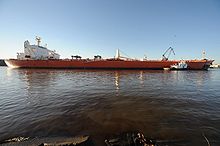Collision
The barge collided with the tanker at about 09:30 local time on January 23, 2010, [2] in the Sabine-Neches Waterway [3] as the tanker, chartered by Exxon-Mobil from AET Incorporated to move oil to Exxon's refinery in Beaumont, Texas, moved upstream, and the barge was being maneuvered out of the harbor. [4] The collision tore a 15 × 8-foot (2.4 m) hole in the side of the tanker, [2] through 450,000 US gallons (1,700,000 L), or 1,500 tonnes, of crude oil, escaped. According to statements from the tanker's crew, the tank that was damaged contained 80,000 barrels (13,000 m3) of oil, of which 69,000 had been transferred to another tank, leaving 11,000 barrels (1,700 m3), or 450,000 US gallons (1,700,000 L) unaccounted for. According to local officials, however, there did not appear to be that much oil in the water, and some said that as little as a thousand barrels, or 42,000 US gallons (160,000 L), of oil had spilled. Coast Guard officials acknowledged that this might be the case, and that oil could have remained in the damaged tank. [5] Referring to the size of the spill, a Coast Guard officer said, "This is a big one." In response to the spill, emergency crews evacuated about 28 blocks of buildings around the site of the collision, but by the evening of the 23rd, residents had been allowed to return. [4]
Aftermath
A perimeter was established around the affected area, and none of the oil had harmed local wildlife. [4] The collision occurred in a still part of the channel, which helped to limit the flow of oil both upstream or downstream. AET activated their OPA 90 response plan and called upon Resolve Marine to lighter and refloat the damaged vessel while contractors worked to contain the oil spilled. [6] While the section of the waterway the collision occurred in is largely industrial, there are marshes along shorelines in other parts that are susceptible to damage from oil spills. [7] The collision closed the Port Arthur waterway, and Coast Guard personnel could not immediately comment on how long it would take to clean the spill or reopen the channel. The only statement made regarding the time it would take to reopen the waterway was that "We're working as quickly as possible to clean up the spill," according to a Coast Guard officer. [3] By the day after the incident, about 1,100 barrels (170 m3) of spilled oil had been recovered, and most of the unrecovered oil was contained. However, according to both the Coast Guard and local officials, the possibility of currents in the channel picking up remained, and with it the potential for oil to flow downstream into marshes. [8] Four oil refineries operate in the Port Arthur area, with a total capacity of about 1.1 million barrels (170,000 m3) of oil a day. In statements, neither Exxon or Valero, which operate two of the refineries, said they expected operations to be disrupted by the collision. Neither Motiva Enterprises or Total, which operate the other two refineries, initially publicly responded to the spill. [4] In its response to the incident, the tanker's operator, AET Inc. said it was cooperating with investigators, and was prepared to bear the costs of cleanup, but noted that responsibility for the incident had not been determined. The company also refused to name the pilots in charge of the ship at the time of the collision. [8] On January 27, the tanker was removed from the waterway, and soon after, limited traffic through the channel was allowed to resume. In a statement on January 29, the Coast Guard said they hoped to allow full operations in the waterway to resume within a week. [9]
Effect on industry
The collision entirely closed the waterway for four days, with limited ship traffic allowed to resume January 27, with operations planned to return to normal by February 5. A total of 26 oil tankers were affected by the collision, with eight vessels waiting at the mouth of the channel by the time it was partially reopened. An officer from the Coast Guard said that their intent was to allow the largest tankers through the channel first. In response to the incident, the oil refinery operated by Motiva Enterprises reduced production by 110,000 barrels (17,000 m3) per day, although whether other refineries reduced production was not clear, as further statements were not released from the operators of the refineries. [9]
This page is based on this
Wikipedia article Text is available under the
CC BY-SA 4.0 license; additional terms may apply.
Images, videos and audio are available under their respective licenses.


